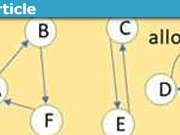Learn Statistical Mechanics: The Ideal Gas
Read Part 1: Equilibrium Systems
Table of Contents
The Ideal Gas: Boltzmann’s Approach (The Microcanonical Ensemble)
Consider a monatomic gas of ##N## non-interacting particles with mass ##m## occupying the volume ##V##. Since the particles of the gas do not interact with each other, it is not difficult to explicitly calculate ##\Omega_{E}##. The position of each particle is constrained to be within the volume ##V## and the momentum is constrained to satisfy ##\sum_{i=1}^{N}p_{i}^{2}=2mE##.
To count the number of unique locations in the volume, we must somehow quantize the volume. Let’s consider the volume to be quantized as ##v\equiv V/h^{3}##. The number of ways to distribute ##N## particles across ##v## partitions is
$$\frac{(N+v-1)!}{N!(v-1)!}$$
If the number of allowed spatial locations and the number of particles is very large, such that ##v>>1## and ##N>>1##, then Stirling’s approximation can be used to give
$$\frac{(N+v-1)!}{N!(v-1)!}\approx\frac{(N+v)!}{N!v!}\approx\frac{(N+v)^{N+v}}{N^{N}v^{v}}\approx\frac{v^{N}(N+v)^{v}}{N^{N}v^{v}}$$
Now if we consider that the number of spatial configurations is much larger than the number of particles, such that ##v>>N##, then we can use the approximation ##(1+N/v)^{v}\approx e^{N}## along with a final application of Stirling’s approximation to give
$$\frac{v^{N}(N+v)^{v}}{N^{N}v^{v}}=\frac{v^{N}(1+N/v)^{v}}{N^{N}}\approx\frac{v^{N}e^{N}}{N^{N}}\approx\frac{v^{N}}{N!}$$
The size of the allowed phase space is the product of the distinct spacial coordinates ##v^{N}/N!## and the surface of a ##3N## dimensional sphere in momentum space with radius ##\sqrt{2mE}##.
The area of a ##d##-dimensional sphere of radius ##R## is
$$A=\frac{2\pi^{d/2}}{(d/2-1)!}R^{d-1}$$
Thus the available phase space is
$$\Omega_{E}=\frac{v^{N}}{N!}\frac{2\pi^{3N/2}}{(3N/2-1)!}(2mE)^{(3N-1)/2}$$
Since ##N>>1##, this can be approximated as
$$\Omega_{E}=\frac{2}{N!(3N/2)!}(2\pi v^{2/3}mE)^{3N/2}$$
The entropy is obtained from Boltzmann’s formula:
$$S=k\ln\Omega_{E}=k\ln\left[\frac{2}{N!(3N/2)!}(2\pi v^{2/3}mE)^{3N/2}\right]$$
Applying Stirling’s approximation gives
$$S=k\left[\ln 2+\frac{3N}{2}\ln\left(2\pi v^{2/3} mE\right)-N\ln N+N-\frac{3N}{2}\ln\left(\frac{3N}{2}\right)+\frac{3N}{2}\right]$$
In the thermodynamic limit, terms of order 1 can be dropped, giving the Sackur-Tetrode equation:
$$S=k\left[\frac{3N}{2}\ln\left(2\pi v^{2/3} mE\right)-N\ln N-\frac{3N}{2}\ln\left(\frac{3N}{2}\right)+\frac{5N}{2}\right]$$
$$S=Nk\left\{\ln\left[\frac{V}{N}\left(\frac{4\pi mE}{3h^{2}N}\right)^{3/2}\right]+\frac{5}{2}\right\}$$
The properties of the ideal gas can now be found using the combined first and second law: ##TdS=dE+PdV-\mu dN##. The temperature is related to the internal energy as
$$\frac{1}{T}=\frac{\partial S}{\partial E}\bigg|_{N,V}=\frac{3}{2}\frac{Nk}{E}\Longrightarrow E=\frac{3}{2}NkT$$
while the pressure is related to volume and temperature as
$$\frac{P}{T}=\frac{\partial S}{\partial V}\bigg|_{N,E}=\frac{Nk}{V} \Longrightarrow PV=NkT$$
Thus we have arrived at the familiar equation of state for an ideal gas.
The Ideal Gas: The Canonical Ensemble
We can generalize the definition of the discrete partition function found in part one to a classical continuum system by replacing the sum with an integral over the phase space.
$$Z=\frac{1}{N!h^{3N}}\int\cdots\int\exp\left(-\beta \mathcal{H}\right)d^{3}\mathbf{p}_{1}\cdots d^{3}\mathbf{p}_{N}d^{3}\mathbf{r}_{1}\cdots d^{3}\mathbf{r}_{N}$$
The total energy is represented by the Hamiltonian ##\mathcal{H}=\sum_{i=1}^{N}|\mathbf{p}_{i}|^{2}/2m##. The spatial integrals are easily evaluated to give
$$Z=\frac{V^{N}}{N!h^{3N}}\int\cdots\int\exp\left(-\beta \sum_{i=1}^{N}\frac{|\mathbf{p}_{i}|^{2}}{2m}\right)d^{3}\mathbf{p}_{1}\cdots d^{3}\mathbf{p}_{N}$$
Since the integral for each particle and each component of ##\mathbf{p}## are identical, this can be written as
$$Z=\frac{V^{N}}{N!h^{3N}}\left[\int_{-\infty}^{\infty}\exp\left(-\beta\frac{p^{2}}{2m}\right)dp\right]^{3N}$$
which is easily evaluated to give
$$Z=\frac{V^{N}}{N!}\left(\frac{2\pi m}{h^{2}\beta}\right)^{3N/2}$$
The free energy can be found in the partition function as
$$F=-kT\ln\left[\frac{V^{N}}{N!}\left(\frac{2\pi mkT}{h^{2}}\right)^{3N/2}\right]=-kT\left\{N\ln\left[V\left(\frac{2\pi mkT}{h^{2}}\right)^{3/2}\right]-\ln N!\right\}$$
Again, assuming the thermodynamic limit, Stirling’s approximation can be used to give
$$F=-NkT\left\{\ln\left[V\left(\frac{2\pi mkT}{h^{2}}\right)^{3/2}\right]-\ln N+1\right\}$$
which leads to the following expression for the entropy:
$$S=-\frac{\partial F}{\partial T}=Nk\left\{\frac{3}{2}+\ln\left[V\left(\frac{2\pi mkT}{h^{2}}\right)^{3/2}\right]-\ln N+1\right\}$$
$$S=Nk\left\{\ln\left[\frac{V}{N}\left(\frac{2\pi mkT}{h^{2}}\right)^{3/2}\right]+\frac{5}{2}\right\}$$
The energy can now be related to the temperature of the gas using the definition of Helmholtz free energy.
$$S=\frac{E-F}{T}$$
$$Nk\left\{\frac{3}{2}+\ln\left[V\left(\frac{2\pi mkT}{h^{2}}\right)^{3/2}\right]-\ln N+1\right\}=\frac{E}{T}+Nk\left\{\ln\left[V\left(\frac{2\pi mkT}{h^{2}}\right)^{3/2}\right]-\ln N+1\right\}$$
$$\frac{3}{2}Nk=\frac{E}{T}\Longrightarrow E=\frac{3}{2}NkT$$
The equation of state is obtained from
$$P=-\frac{\partial F}{\partial V}\bigg|_{T,N}=\frac{kTN}{V}\Longrightarrow PV=NkT$$
We have again arrived at the proper equation of state for an ideal gas. This shows how different thermodynamic ensembles lead to the same equation of state when taken to the thermodynamic limit. For most systems, however, there is often only one ensemble that is easy to use and solve for. The ideal gas, because of its simplicity, is a rare example of a system that can be exactly solved in multiple ensemble types.
Education: Graduate student in physics; specializing in biophysics and non-linear dynamics.
Hobbies: Astrophotography, Electronics, and Mineral collecting








First of all, phase space is not descritized in quantum theory. Second, the choice of the natural phase-space volume to be able to define phase-space distribution functions has been the greatest enigma for Maxwell and Boltzmann when formulating classical statistical theory.
Quantum theory resolves this problem without further thought since it implies that the single-particle phase-space-cell measure indeed is ##h^3=(2 pi hbar)^3##. Indeed to establish statistical mechanics, you have to define a phase-space distribution function for a single particle ##f(t,vec{x},vec{p})## which must have the dimension of inverse action cubed, because that's the dimension of phase-space volume ##mathrm{d}^3 x mathrm{d}^3 p##.
Now suppose you have a particle in a spatial volume ##mathrm{d}^3 x##. Then imposing periodic boundary conditions you find that there are ##mathrm{d}^3 x mathrm{d}^3 p/(2 pi hbar)^3## quantum states. This implies that the phase-space distribution function has to be normalized such that
$$int_{mathbb{R}^3} mathrm{d}^3 x int_{mathbb{R}^3} mathrm{d}^3 p frac{1}{(2 pi hbar)^3} f(t,vec{x},vec{p})=1,$$
i.e., QT uniquely defines the appropriate single-particle phase-space measure as ##(2 pi hbar)^3##. For details see
https://th.physik.uni-frankfurt.de/~hees/publ/kolkata.pdf
The point is to discritize the phase space and tacking on the h3h^{3} term accomplishes this in an intuitive, although not exactly correct, way.Why is it intuitive? Is the assertion that h-bar is a reasonable lower bound based on uncertainty, and because there are three dimensions in the volume it needs to be cubed?
Now it's better. Only in the third-last formula you should again combine the two ln terms :-).
It's not "space space" (I guess you mean "configuration space")Yes, that was a typo.
And yes, there are logarithms with dimensionful quantities in their arguments. As far as I can see you can very easily repair it by taking the logarithms together since I think the formulae are in principle right!These should be fixed now. I was originally doing the derivation with dimensionless variables but then later switched to dimensionful variables, but forgot to change this in the article.
It's not "space space" (I guess you mean "configuration space") but "phase space" that's to be divided into cells of the size ##(2 pi hbar)^{3f}##!
For the case of an ideal gas, it's easily derived by solving the problem for the single-particle phase space. See my kinetic-theory manuscript for that:
https://th.physik.uni-frankfurt.de/~hees/publ/kolkata.pdf
And yes, there are logarithms with dimensionful quantities in their arguments. As far as I can see you can very easily repair it by taking the logarithms together since I think the formulae are in principle right!
I think it should be mentioned that here tacitly the Bose distribution was used to count the states without giving the argument for why to use Planck's constant h=2πℏh=2πℏh=2pi hbar, which is of course a measure of phase space not spatial volume.You're right that I never proved that using Planck's constant yields the correct discritization of the space space. Rather, I assumed it a priori as a reasonable guess which yields the right answer. It's also true that dividing the volume by Planck's constant doesn't really mean anything physical on its own. The point is to discritize the phase space and tacking on the ##h^{3}## term accomplishes this in an intuitive, although not exactly correct, way.
there are dimensionful quantities as arguments in logarithms. This should be corrected.Are you referring to the logarithms after applying Stirling's approximation?
Great work! Will there be a part 3?Yes, I intend to do a few more parts as time permits.
I think it should be mentioned that here tacitly the Bose distribution was used to count the states without giving the argument for why to use Planck's constant ##h=2pi hbar##, which is of course a measure of phase space not spatial volume.
That's definitely not the way Boltzmann did it. Of course, it's correct, but the classical result comes from doing a rather tough approximation using Stirlings formula, which is in fact a bit tricky anyway. Another problem is that in the given expression of the entropy there are dimensionful quantities as arguments in logarithms. This should be corrected. Otherwise it's a very nice derivation in the microcanonical ensemble.
For a treatment (however in the context of kinetic theory), see section 1.8 of
https://th.physik.uni-frankfurt.de/~hees/publ/kolkata.pdf
Great article!
I haven’t read much about Stat Mech in over forty years. I think we used only one ensemble in our undergrad coursework.
Your article was very insightful. Thanks!
Another example of an Insight that made me a real fan of this PF feature. Is it the practice here or the special mentality, that makes them readable in a way, that all crucial keywords are mentioned and the explanation is still somewhere above the boring of a textbook and the out-of-context of a Wiki article, i.e. close to what an actual lecture would be. Absolute an appetizer for non specialists like me!
I wonder if it were possible to make an index of all of them.
Great work! Will there be a part 3?